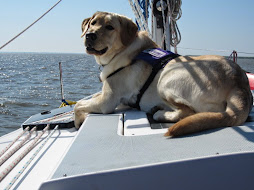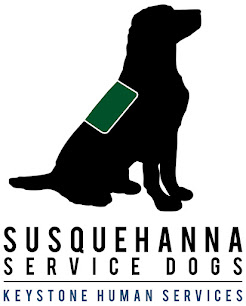 As soon as we walk into the room, we can hear the soft squeaking noises of nine puppies. SSD Winter, the proud mom of the newest litter of Susquehanna Service Dogs, pads over to greet us, then flops down at our feet, the picture of a tired mom. Winter’s breeder caretaker family is tired, too – the puppies must be fed and cared for every four hours around the clock. And yet, even though everyone is ready for a nap, there’s a feeling of exhilaration. All because three feet away, in a box lined with a heating pad and plenty of towels and blankets, are nine little puppies, wriggling, sleeping and making those adorable little puppy noises.
As soon as we walk into the room, we can hear the soft squeaking noises of nine puppies. SSD Winter, the proud mom of the newest litter of Susquehanna Service Dogs, pads over to greet us, then flops down at our feet, the picture of a tired mom. Winter’s breeder caretaker family is tired, too – the puppies must be fed and cared for every four hours around the clock. And yet, even though everyone is ready for a nap, there’s a feeling of exhilaration. All because three feet away, in a box lined with a heating pad and plenty of towels and blankets, are nine little puppies, wriggling, sleeping and making those adorable little puppy noises.Born September 3, 2009, the puppies will live with their breeder caretaker family until they are seven weeks old. Winter’s maternal instincts are not strong, and she doesn’t have enough milk to feed nine puppies, so we need to do many of the tasks she would normally do.
The mother usually licks her pups to stimulate their digestive system. To mimic Winter’s tongue, we use a cotton pad soaked in warm water to rub the puppies’ bellies. Because Winter does have some milk, we make sure that all the puppies have a turn at nursing, but we supplement them by bottle-feeding them puppy formula.
 The breeder caretakers must stimulate and feed Shamrock, Slate, Denim, Rusty, Sienna, Lavender, Onyx, Copper and Jade every four hours – an exhausting, but rewarding process, especially when you can see the puppies doubling and tripling their birth weight! (By Day 9, the puppies had doubled their birth weight!)
The breeder caretakers must stimulate and feed Shamrock, Slate, Denim, Rusty, Sienna, Lavender, Onyx, Copper and Jade every four hours – an exhausting, but rewarding process, especially when you can see the puppies doubling and tripling their birth weight! (By Day 9, the puppies had doubled their birth weight!)In addition to caring for the puppies’ needs, we do Early Neurological Stimulation (ENS) with them until they’re 18 days old. Developed by the US Military for their canine program, ENS became popularly known as the “Super Dog” program because if it’s done properly, it can greatly increase the dogs’ neurological capacities.
We perform five exercises in order once each day with each puppy:
1. Tickle between the puppy’s toes with a Q-tip. (3-5 seconds)
2. Hold the puppy straight up in the air so its head is vertically in line with its tail. (3-5 seconds)
3. Hold the puppy upside down so its head is vertically in line with its tail. (3-5 seconds)
4. Hold the puppy on its back. (3-5 seconds)
5. Place the puppy on a damp cloth that has been refrigerated for at least five minutes. (3-5 seconds)

Performing these exercises can kick the puppies’ neurological system into action earlier then it normally would. Studies have shown that dogs that have been exposed to ENS are more resistant to disease and have a greater tolerance for stress. In addition, dogs that have gone through ENS perform better in problem-solving situations and tend to be more active in exploring their environment. If you would like to learn more about ENS, read Dr. Carmen Battaglia’s article about it.
These capacities are especially important for service dogs. Service dogs will need to learn many new behaviors, sometimes even figuring out a new behavior on their own, and they will continually learn new skills as they adapt to their partners’ needs. They will need to generalize the behavior, performing it in many different environments that can often be stressful for the dog. The ability to stay calm and focused is necessary for service dogs to assist their partners.
ENS will give Shamrock, Slate, Denim, Rusty, Sienna, Lavender, Onyx, Copper and Jade an advantage as they grow and start to learn the skills they’ll need as service dogs.
We will continue to share updates on the puppies' progress. The puppies will be eating their first meal of real food (softened puppy food, or puppy gruel) within the next two weeks. Look for a post about their adventure with real food!
Also, we are going to have a Puppy Cam for the Crayon litter. It will be streaming live on Ustream and you'll also be able to watch it on our website. We'll have more information about the Puppy Cam soon!









No comments:
Post a Comment